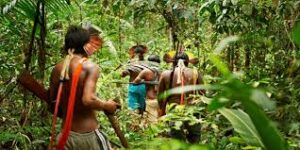NCERT Solutions for Class 10 Social Science Geography Chapter 2 Forest and Wildlife Resources
1 . Multiple choice questions
(i) Which of the following conservation strategies do not directly involve community participation?
(a) Joint forest management
(b) Beej Bachao Andolan
(c) Chipko Movement
(d) Demarcation of Wildlife sanctuaries
Answer: (d) Demarcation of Wildlife Sanctuaries
Solution: Demarcation of wildlife sanctuaries primarily involves the physical marking or establishment of boundaries for protected areas to safeguard wildlife and their habitats. While it is an important strategy for conservation, it does not require active or direct participation of local communities in its implementation or management. The primary focus here is on setting the boundaries and regulations for wildlife protection rather than involving the community in decision-making and sustainable resource management.

On the other hand:
- Joint Forest Management involves collaboration between local communities and forest authorities in the management and protection of forests.
- Chipko Movement is a community-based movement where local villagers participate in hugging trees to prevent their felling and promote environmental conservation.
- Beej Bachao Andolan is a movement for saving seeds and promoting agro-biodiversity, often with active participation from farmers and communities.
(ii) Match the following.
| Reserved forests | other forests and wastelands belonging to both government and private individuals and communities |
| Protected forests | forests are regarded as most valuable as far as the conservation of forest and wildlife resources |
| Unclassed forests | forest lands are protected from any further depletion |
Ans:

3. Answer the following questions in about 30 words.
(i) What is biodiversity? Why is biodiversity important for human lives?
Ans: Biodiversity refers to the variety of life forms, including plants, animals, and microorganisms, in a particular ecosystem. Biodiversity is crucial for human lives as it provides essential ecosystem services such as clean air, water, food, and medicines. Biodiverse ecosystems contribute to climate regulation, soil fertility, and pest control.

(ii) How have human activities affected the depletion of flora and fauna? Explain.
Ans: Human activities, such as habitat destruction, pollution, invasive species, overexploitation, and climate change, have caused significant depletion of flora and fauna. These impacts disrupt ecosystems, threaten species’ survival, and contribute to biodiversity loss.

4. Answer the following questions in about 120 words.
(i) Describe how communities have conserved and protected forests and wildlife in India?
Ans: Communities in India have played a crucial role in conserving and protecting forests and wildlife through various traditional and modern approaches. The significance of community involvement lies in their intimate connection with local ecosystems and sustainable resource use practices.

Historically, indigenous and tribal communities have practiced community-based conservation, such as sacred groves and customary laws that restrict hunting and logging. The Chipko Movement, where villagers hugged trees to prevent their felling, showcased grassroots efforts for forest protection.
In modern times, Joint Forest Management (JFM) and Community Reserves involve collaboration between local communities and forest departments, empowering them in decision-making, afforestation, and sustainable resource use. Bishnoi communities in Rajasthan and Van Panchayats in Uttarakhand exemplify successful local initiatives.
Additionally, eco-tourism and community-based wildlife management have provided economic incentives for conserving wildlife. Local participation in projects like Project Tiger and Project Elephant showcases community-led wildlife protection.
By nurturing a sense of ownership and benefiting from sustainable practices, communities contribute significantly to forest and wildlife conservation, thereby fostering ecological balance and ensuring the long-term health of India’s natural heritage.
(ii) Write a note on good practices towards conserving forest and wildlife
Ans: Conserving forests and wildlife is vital for maintaining ecological balance and ensuring sustainable development. Several good practices contribute to effective conservation efforts:
- Habitat Protection: Establishing protected areas, wildlife sanctuaries, and national parks safeguards habitats and allows species to thrive undisturbed.
- Community Participation: Involving local communities in conservation decisions promotes responsible resource use and generates support for protection efforts.
- Sustainable Resource Management: Implementing sustainable logging, fishing, and hunting practices prevents overexploitation and ensures resources for future generations.
- Afforestation and Reforestation: Planting native tree species and restoring degraded areas enhance biodiversity and combat deforestation.
- Anti-Poaching Measures: Strengthening anti-poaching patrols, using technology for monitoring, and enforcing strict penalties deter illegal wildlife trade and hunting.
- Wildlife Corridors: Establishing corridors between protected areas allows species to move freely, reducing habitat fragmentation.
- Awareness and Education: Public awareness campaigns and educational programs inform people about the importance of conservation and encourage responsible behavior.
- Eco-Tourism: Sustainable tourism generates income for communities while raising awareness about wildlife and habitat conservation.
- Research and Monitoring: Regular monitoring of species, habitats, and ecosystem health informs conservation strategies and policy decisions.
- International Cooperation: Collaborating with neighboring countries on trans-boundary conservation efforts helps protect migratory species and shared ecosystems.
These practices, when integrated into comprehensive conservation strategies, contribute to safeguarding forests and wildlife for present and future generations, ensuring a harmonious coexistence between human needs and nature’s richness.
NCERT Solutions for Class 10 Social Science Geography
Thanks for reading NCERT Solutions for Class 10 Social Science Geography Chapter 2 Forest and Wildlife Resources.